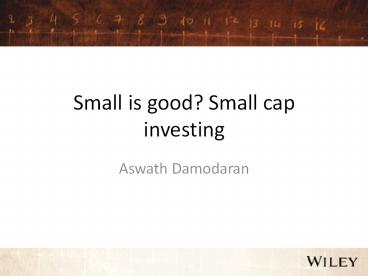Small is good? Small cap investing PowerPoint PPT Presentation
Title: Small is good? Small cap investing
1
Small is good? Small cap investing
- Aswath Damodaran
2
Small Cap Investing Is it growth investing?
- In small cap investing, you invest in companies
with low market capitalization. - While some small cap investing is directed
towards value stocks, the underlying basis for
investing in small companies is often the belief
that you have a much greater likelihood of
getting growth at these companies, at a
reasonable price. - There is substantial empirical evidence backing
this strategy, though it is debatable whether the
additional returns earned by this strategy are
really excess returns.
3
Small companies have been winners over long time
periods
4
And it shows up globally
5
Though the small Firm Effect has varied over time
6
And there have been cycles in Small Firm Premium
7
Is there a small cap premium?
- The small stock has become much more volatile
since 1981. Whether this is a long term shift in
the small stock premium or just a temporary dip
is still being debated. - Jeremy Siegel notes in his book on the long term
performance of stocks that the small stock
premium can be almost entirely attributed to the
performance of small stocks in the 1970s. Since
this was a decade with high inflation, could the
small stock premium have something to do with
inflation?
8
And even if there is one, is it all in January?
9
Possible Explanations
- It costs more to trade small cap stocks The
transactions costs of investing in small stocks
is significantly higher than the transactions
cots of investing in larger stocks, and the
premiums are estimated prior to these costs.
While this is generally true, the differential
transactions costs are unlikely to explain the
magnitude of the premium across time, and are
likely to become even less critical for longer
investment horizons. - Difficult to replicate Funds that invest in
small cap stocks are often unable to deliver the
premiums that you see in the paper portfolios
that back the small cap effect.
10
Difficulties in Replicating Small Firm Effect
11
Risk Models and the Size Effect
- The capital asset pricing model may not be the
right model for risk, and betas under estimate
the true risk of small stocks. Thus, the small
firm premium is really a measure of the failure
of beta to capture risk. The additional risk
associated with small stocks may come from - Estimating risk The estimation risk associated
with estimates of beta for small firms is much
greater than the estimation risk associated with
beta estimates for larger firms. The small firm
premium may be a reward for this additional
estimation risk. - Information risk There may be additional risk
in investing in small stocks because far less
information is available on these stocks. In
fact, studies indicate that stocks that are
neglected by analysts and institutional investors
earn an excess return that parallels the small
firm premium.
12
There is less analyst coverage of small firms
13
But the risk in individual small stocks may not
show up in a portoflio
- While it is undeniable that the stock returns for
individual small cap stocks are much more
volatile than large market cap stocks, a
portfolio of small cap stocks has a distribution
that is similar to the distribution for a large
cap portfolio.
14
Determinants of Success at Small Cap Investing
- The importance of discipline and diversification
become even greater, if you are a small cap
investor. Since small cap stocks tend to be
concentrated in a few sectors, you will need a
much larger portfolio to be diversified with
small cap stocks. In addition, diversification
should also reduce the impact of estimation risk
and some information risk. - When investing in small cap stocks, the
responsibility for due diligence will often fall
on your shoulders as an investor, since there are
often no analysts following the company. You may
have to go beyond the financial statements and
scour other sources (local newspapers, the firms
customers and competitors) to find relevant
information about the company. - Have a long time horizon.
15
The importance of a long time horizon..

